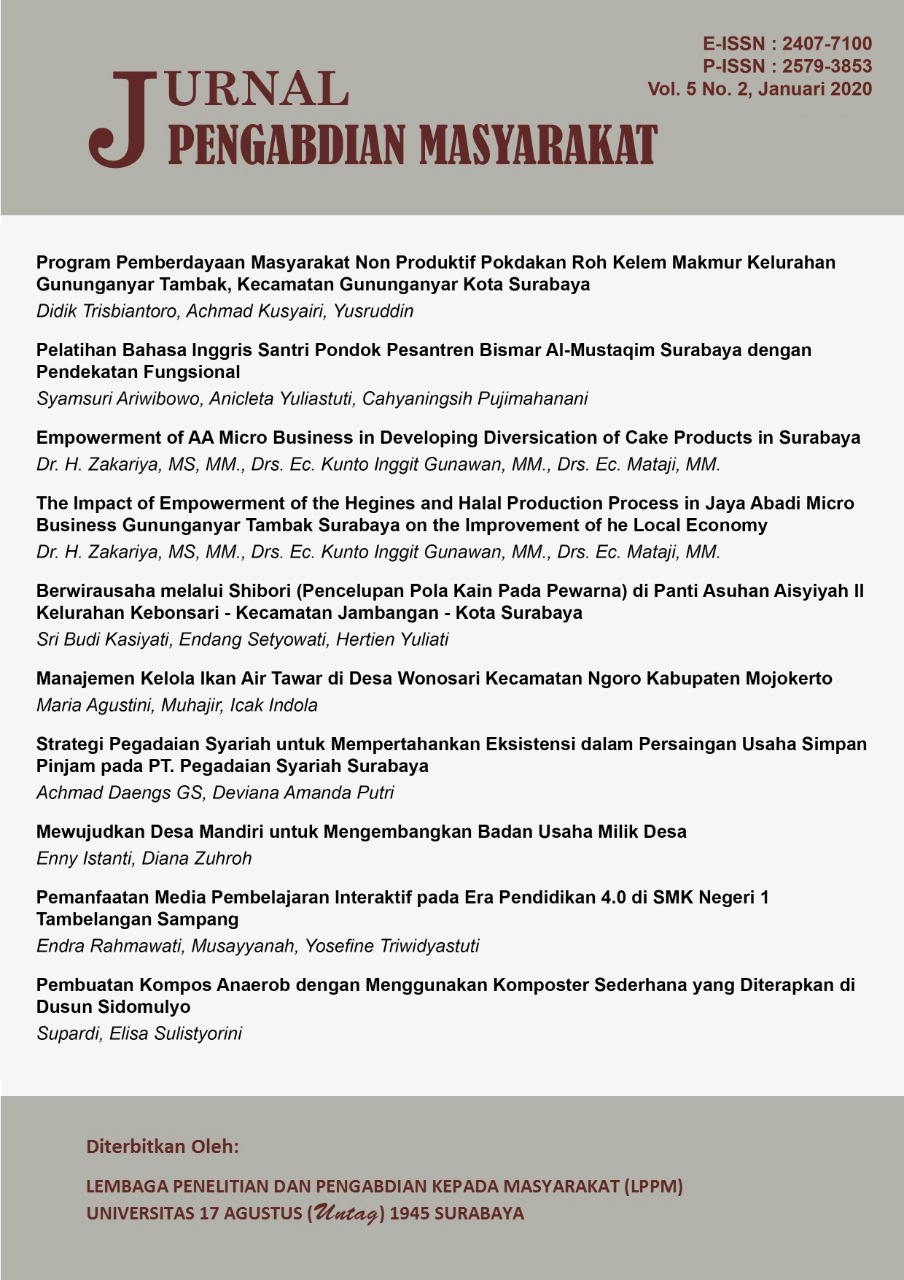PEMBUATAN KOMPOS ANAEROB DENGAN MENGGUNAKAN KOMPOSTER SEDERHANA YANG DITERAPKAN DI DUSUN SIDOMULYO
DOI:
https://doi.org/10.30996/jpm17.v5i2.4095Abstract
Organic waste from household can cause air pollution, produces stench. Actually, organic waste can be used to make compost. compost is very useful for fertilizing plants. The purpose of the enlightenment is making compost. The making compost education as an effort to empower low educate communities and optimize the use of organic waste to produce compost. Making compost also can improve skill of communities in Sidomulyo, Babakbowo, Gresik. The long term goal of this extension program is increasing the intelligence and provision of skills to be able to make their own compost and composter. The method that used in the community service program is counseling and assistance in making compost from organic waste. The step of this program began with the socialization and counseling of making compost and composter from household waste. The composter is made by using anaerob composter system.
Keywords: Compost, Organic, Anaerob
Downloads
References
Sahwan, F., Wahyono, S., & Suryanto, F. (2016). Kualitas Kompos Sampah Rumah Tangga Yang Dibuat Dengan Menggunakan ”Komposter” Aerobik. Jurnal Teknologi Lingkungan, 12(3), 233. https://doi.org/10.29122/jtl.v12i3.1231
Yetri, Y., Nur, I., & Hidayati, R. (2018). Produksi Pupuk Kompos Dari Sampah Rumah Tangga. Jurnal Katalisator, 3(2), 77. https://doi.org/10.22216/jk.v3i2.2818
Elpawati, E., Dara, S. D., & Dasumiati, D. (2016). Optimalisasi Penggunaan Pupuk Kompos dengan Penambahan Effective Microorganism 10 (Em10) pada Produktivitas Tanaman Jagung (Zea mays L.). AL-Kauniyah: Jurnal Biologi, 8(2), 77–87. https://doi.org/10.15408/kauniyah.v8i2.2693
Sya’bani, M. R. (2016). Komposter sampah organik.
Nugraha, N. (2018). Rancang Bangun Komposter Rumah Tangga Komunal Sebagai Solusi Pengolahan Sampah Mandiri Kelurahan Pasirjati Bandung. Creative Research Journal, 3(02), 105. https://doi.org/10.34147/crj.v3i02.109
Ekawandani, N., & Kusuma, A. A. (2018). Pengomposan sampah organik (kubis dan kulit pisang) dengan menggunakan EM4. Tedc, 12(1), 38–43.
Sriharti, O. (2010). Untuk Pembuatan Kompos, (2005), 1–8.
Rahmawanti, N., & Dony, N. (2014). Pembuatan Pupuk Organik Berbahan Sampah Organik Rumah Tangga Dengan Penambahan Aktivator EM 4 Di Daerah Kayu Tangi. Ziraa’ah Majalah Ilmiah Pertanian, 39(1), 1–7.
Sahwan, F. L., Irawati, R., & Suryanto, F. (2016). Efektivitas Pengkomposan Sampah Kota Dengan Menggunakan “Komposter” Skala Rumah Tangga. Jurnal Teknologi Lingkungan P3TL-BPPT, 5(2), 134–139. https://doi.org/10.29122/jtl.v5i2.309
Jaelani, A., Purwanti, H. I., & Aziz, M. R. (2014). Pemanfaatan Komposter Sederhana Sebagai Solusi Alternatif Mengatasi Sampah di Perumahan Podosugih Kota Pekalongan. Program Kreativitas Mahasiswa - Pengabdian Kepada Masyarakat, 1(28). Retrieved from http://artikel.dikti.go.id/index.php/PKMM/article/view/103/104
Badan Litbang Pertanian. (2011). Pupuk Organik dari Limbah Organik Sampah Rumah Tangga. Agroinovasi, (3417), 2–11. Retrieved from http://www.litbang.pertanian.go.id/download/one/184/file/Pupuk-Organik-dari-Limbah.pdf
Lumbanraja, P. (2014). PRINSIP DASAR PROSES PENGOMPOSAN.
Downloads
Published
Issue
Section
License
COPYRIGHT NOTICE
The copyright in this website and the material on this website (including without limitation the text, computer code, artwork, photographs, images, music, audio material, video material and audio-visual material on this website) is owned by PM17: Jurnal Pengabdian Masyarakat and its licensors.
Copyright license
JPM17: Jurnal Pengabdian Masyarakat grants to you a worldwide non-exclusive royalty-free revocable license to:
- View this website and the material on this website on a computer or mobile device via a web browser;
- Copy and store this website and the material on this website in your web browser cache memory; and
- Print pages from this website for your
- All articles published by PM17: Jurnal Pengabdian Masyarakat are licensed under the creative commons attribution 4.0 international license. This permits anyone to copy, redistribute, remix, transmit and adapt the work provided the original work and source is appropriately cited.
JPM17: Jurnal Pengabdian Masyarakat does not grant you any other rights in relation to this website or the material on this website. In other words, all other rights are reserved.
For the avoidance of doubt, you must not adapt, edit, change, transform, publish, republish, distribute, redistribute, broadcast, rebroadcast or show or play in public this website or the material on this website (in any form or media) without appropriately and conspicuously citing the original work and source or JPM17: Jurnal Pengabdian Masyarakat prior written permission.
Permissions
You may request permission to use the copyright materials on this website by writing to compliance@academicjournals.org.
Enforcement of copyright
JPM17: Jurnal Pengabdian Masyarakat takes the protection of its copyright very seriously.
If JPM17: Jurnal Pengabdian Masyarakat discovers that you have used its copyright materials in contravention of the license above, JPM17: Jurnal Pengabdian Masyarakat may bring legal proceedings against you seeking monetary damages and an injunction to stop you using those materials. You could also be ordered to pay legal costs.
If you become aware of any use of ACADEMIC JOURNALS' copyright materials that contravenes or may contravene the license above, please report this by email to compliance@academicjournals.org.
Infringing material
If you become aware of any material on the website that you believe infringes your or any other person's copyright, please report this by email to jpm17@untag-sby.ac.id
target="_blank"














